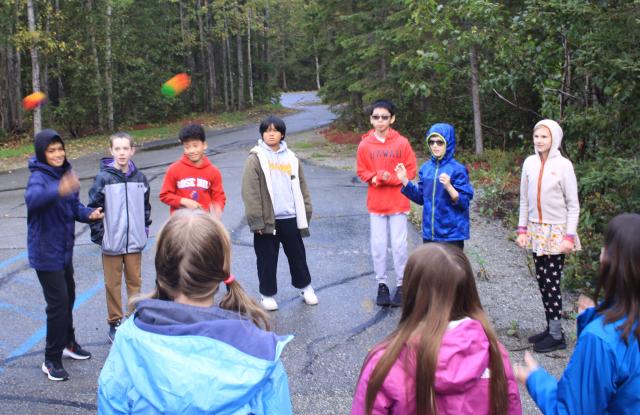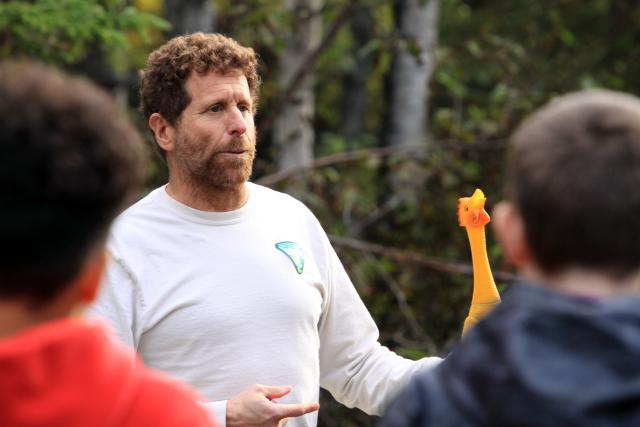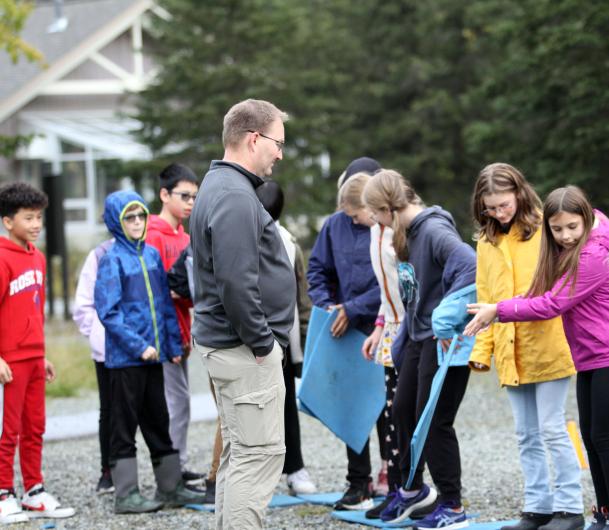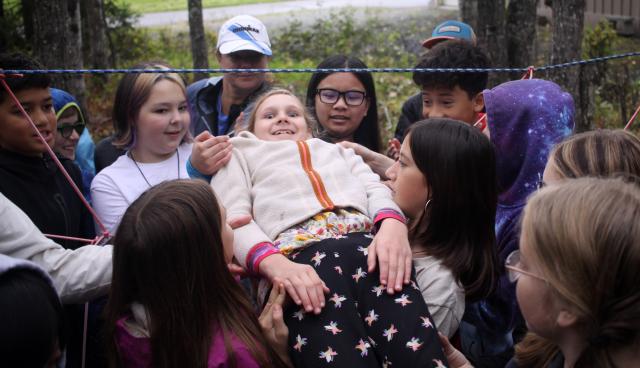You are viewing ARCHIVED content published online before January 20, 2025. Please note that this content is NOT UPDATED, and links may not work. Additionally, any previously issued diversity, equity, inclusion or gender-related guidance on this webpage should be considered rescinded. For current information, visit https://www.blm.gov/blog.
Teamwork saves Koosh balls and students from alligators
Koosh balls, alligators and lava monsters certainly have their place in the world, but seem like an odd combination in Anchorage, Alaska. However, nearly 50 students from Trailside Elementary confronted just that during their visit to BLM Alaska’s Campbell Creek Science Center (CCSC) earlier this month. The students participated in team building programs while building connections to the people and work of BLM Alaska.
The group of students filed in one by one and assembled in the CCSC’s multipurpose room – which, if you haven’t seen it, is an incredible place to hold large gatherings. The students met with CCSC’s Education Technicians Brad Fidel, Brian Janson, and Cecilia Walenza to do a warmup exercise like “Simon Says” and go over some ground rules for the day.
Collectively, Fidel and Janson led a group discussion on SPARK or Safe Prepared Aware Respectful Kids. Both education technicians explained that whatever the activity, always stay safe, be prepared for your environment, be aware of wildlife and what your group is doing and saying, be respectful of others, the CCSC and the environment, and finally to enjoy being a kid – have fun, learn, play, and challenge yourself and each other. The focus for the day’s activities revolved around what makes a good teammate.
After the introductory activity, the students broke out into smaller groups. All performed similar activities, but the smaller groups allowed for an immersive experience and one-on-one interaction with the education technicians. To get a detailed overview of the program, I shadowed Fidel.
Fidel’s group of 15 students gathered on the back patio of the CCSC in the chilled autumn air, sitting in a large circle while Fidel passed out little laminated cards. The students were to pair up and discuss what the word on their card meant to them. A few of the words included decision making – what students Lilly and Margo felt meant making choices – leadership, problem solving, communication, encouragement, trust, flexibility, planning and patience. Students Alexa and Jayden described patience as waiting for the butter to melt and get nice and hot in the pan before you try and scramble eggs. These words and the concepts behind them would be a common theme throughout the day as the children worked through various team building programs.

One such program, group juggling, required the students and their chaperones to form a circle and stand far enough apart to toss a Koosh ball to a partner of their choice. They had to call out their partner’s name, toss the ball, and their partner had to catch the ball without dropping it. Sounds easy, right? The first round went well, but then the students had to do it again remembering who they tossed the ball to and in what order. If memorization skills weren’t enough, somehow invisible alligators made it into the center of the circle and caused the team to lose points every time a ball hit the ground. More Koosh balls went into the mix, first two, then three – and then a rubber chicken named, “Bob,” who stood for chaos. The students quickly learned that the more they communicated with their partners the less alligators they ran into. By the final round, students 15 – alligators zero.

The team building exercises increased in complexity as the day went on. The next one, lava monsters, was sheer mayhem as the students had to figure out how to cross a lava field using only a few lava surfboards (blue foam mats). The cacophony and chaos arising from every student out for themselves transitioned to clear communication, leadership, planning, teamwork, and patience. After a few rough starts, the group made their way safely across the lava field avoiding the pesky lava monsters who were all too eager to snatch those unattended lava surfboards (students needed to always keep physical contact with their mats) away.

Fidel explained that students have a small but profound moment to look at what kind of person they are within the group. Were they someone who was trustworthy? Were they someone who invites others to share in the fun? Did they recognize mistakes that they made during the activity and then change or adapt to the situation? Did they use any of the skills discussed at the beginning of the day? At the end of each activity, the students reflect on these observations knowing that as they progress the programs increase in complexity.
After a brief break for lunch, the students made their way to the giant spider web for their last team building activity of the day. The object of this activity was to make it through the web without touching it and alerting the very hungry spider of any dinner delicacies.

The spider web consisted of ropes stretched between two trees to form a rectangle. Within that rope rectangle more ropes connected to create a series of shapes or holes for the students to crawl through. Some shapes were low to the ground, others were at least four feet off the ground. Some were large enough to crawl through with ease and others were quite small. To make it more of a challenge, the children could only use a hole in the web once. Again, the students needed several restarts before they understood the nature of the game – collaboration, communication, safety and help each other. A few students felt they could do it better on their own and unfortunately did not make it past the giant make-believe spider. Those students either lost their voice or the use of their arms until they made it through the web and the first-aid kit on the other side. Then, an extraordinary shift from the individual to team-focused happened once more as students helped each other one at a time through the holes in the web. The children helped their classmates by guiding them through the lowest and middle portions of the web and hoisting their classmates up and through the highest portions. The entire group helped one student at a time – both in crawling through and out of the web. Always supporting, always communicating, and always staying safe.

Team building exercises like the ones mentioned above help encourage creativity, develop trust, enhance communication and more skills necessary for personal and professional growth and lifelong success.
“The games we play might have silly scenarios, but the skills have real world value the students can use in their everyday life,” said Fidel. “Practicing these skills help students become better communicators, grow confidence in sharing ideas, and take on leadership roles while building trust and helping others succeed.”
Team building exercises are not just for the elementary students. They can be of great benefit to anyone looking to improve productivity, increase morale, develop confidence, inspire collaboration, incite compassion, and given the number of employees in remote work environments, offer a connection and cohesiveness that may be missing.

The Campbell Creek Science Center engages all learners in outdoor experiences that increase appreciation, connection, and stewardship of Alaska’s public lands and natural resources. As part of that mission, the education team at the Campbell Creek Science Center offers these team building events to all students grades 4-12 but hopes to expand these opportunities to other groups (including adults) in the future.
For more information on the Campbell Creek Science Center and the programming it offers, please visit the CCSC’s webpage. If you’re interested in signing up for a team building event with the Campbell Creek Science Center, please contact BLM Alaska Education Specialist Annie Runde at arunde@blm.gov or (907) 267-1225.
<Deborah Coble>, <Acting CCSC Manager>
Related Stories
- BLM Recreation Sites Available to All: Exploring Accessibility on Alaska’s Public Lands
- A boatload of recreational opportunities
- Exploring the Campbell Tract Special Recreation Management Area: Flora, fauna, and volunteer opportunities
- Far more than a few beavers
- Love letters from our public lands: Wolf Run Cabin
Office
5600 Science Center Drive
Anchorage, AK 99507
United States
